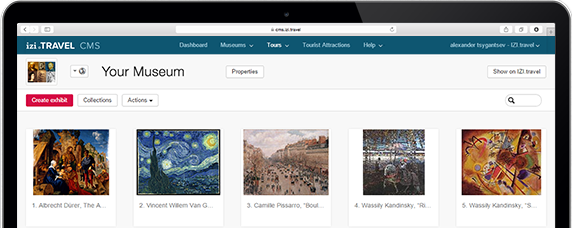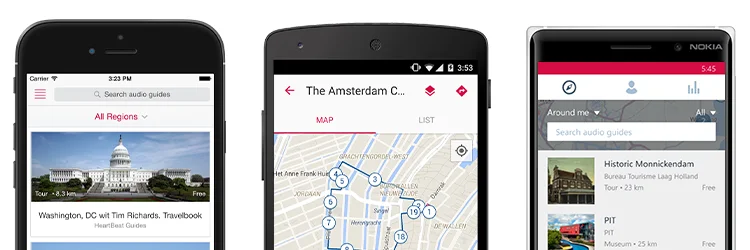Audio tour Vienne : Circuit of Heritage Trails
2 sights
- Audio tour Summary
-
Audio tour Summary
Update Required To play the media you will need to either update your browser to a recent version or update your Flash plugin.A brief history of Vienne
The Vienne region has been inhabited since ancient times. In the 3rd century B.C., the Allobroges Gauls had a small village there which was elevated to the rank of capital. Its loyalty to Rome, during the Gallic war, earned Vienne the title of Latin colony before it was awarded the envied title of Roman colony in 40 A.D. The town grew up on both sides of the Rhône and became one of the largest towns in Gaul. The city enjoyed another heyday from the 4th century onwards when it became the county town in the Vienne province. During the 9th century, Vienne became the capital of the kingdom of Provence. In the 11th century, it became part of the German Holy Roman Empire. The
wealth and power of the archbishops continued to grow; one of them, Guy of Burgundy, was elected
Pope under the name of Calixte II in 1119. He gave the title of primacy to Saint-Maurice Cathedral,
confirming the primacy of the Vienne archdiocese over the provinces.
In 1311-1312, Saint-Maurice Cathedral housed the ecumenical council which, under pressure from King Philippe the Fair, pronounced the dissolution of the Order of the Templars. In 1450, Vienne was attached to the kingdom of France; it was then gradually overshadowed by neighbouring Lyon. The 18th century saw a period of economic revival, thanks to the establishment of cloth manufacturers and metallurgical industries, whose increased development in the 19th century boosted the population. Today, the city of Vienne is mainly centred on tourism and the service sector, although it does have a few high-tech industries. - 1 Tourism pavilion
- 2 Ramparts
- 3 Saint-Pierre Church
- 4 Saint-Pierre Archeological Museum
- 5 Saint-Maurice Cathedral
- 6 Saint-Maurice Cathedral - Western facade
- 7 Place Saint-Paul & Saint-Maurice Cathedral - Northern facade
- 8 Temple to Augustus and Livia
- 9 Rue de la Chaîne / Rue des Clercs
- 10 Rue des Clercs - the doors
- 11 Saint-André-le-Bas church and cloister
- 12 Place du Jeu de Paume
-
Audio tour Summary
Update Required To play the media you will need to either update your browser to a recent version or update your Flash plugin.A brief history of Vienne
The Vienne region has been inhabited since ancient times. In the 3rd century B.C., the Allobroges Gauls had a small village there which was elevated to the rank of capital. Its loyalty to Rome, during the Gallic war, earned Vienne the title of Latin colony before it was awarded the envied title of Roman colony in 40 A.D. The town grew up on both sides of the Rhône and became one of the largest towns in Gaul. The city enjoyed another heyday from the 4th century onwards when it became the county town in the Vienne province. During the 9th century, Vienne became the capital of the kingdom of Provence. In the 11th century, it became part of the German Holy Roman Empire. The
wealth and power of the archbishops continued to grow; one of them, Guy of Burgundy, was elected
Pope under the name of Calixte II in 1119. He gave the title of primacy to Saint-Maurice Cathedral,
confirming the primacy of the Vienne archdiocese over the provinces.
In 1311-1312, Saint-Maurice Cathedral housed the ecumenical council which, under pressure from King Philippe the Fair, pronounced the dissolution of the Order of the Templars. In 1450, Vienne was attached to the kingdom of France; it was then gradually overshadowed by neighbouring Lyon. The 18th century saw a period of economic revival, thanks to the establishment of cloth manufacturers and metallurgical industries, whose increased development in the 19th century boosted the population. Today, the city of Vienne is mainly centred on tourism and the service sector, although it does have a few high-tech industries.
Reviews
7 reviews
Review this tour-
10-04-2022
visite très enrichissante et ludique. Découvrir Vienne tout en étant guidé et pouvoir aller à notre rythme. Parcours bien balisé assez facile même si on a pas trop le sens de l'orientation. Merci beaucoup !
-
02-06-2022
excellente balade patrimoniale bien commentée merci
-
09-09-2020
Excellent
-
01-29-2020
Amine
-
11-02-2018
Génial ! Très bien fait. Merci.
Download the free izi.TRAVEL app
Create your own audio tours!
Use of the system and the mobile guide app is free




